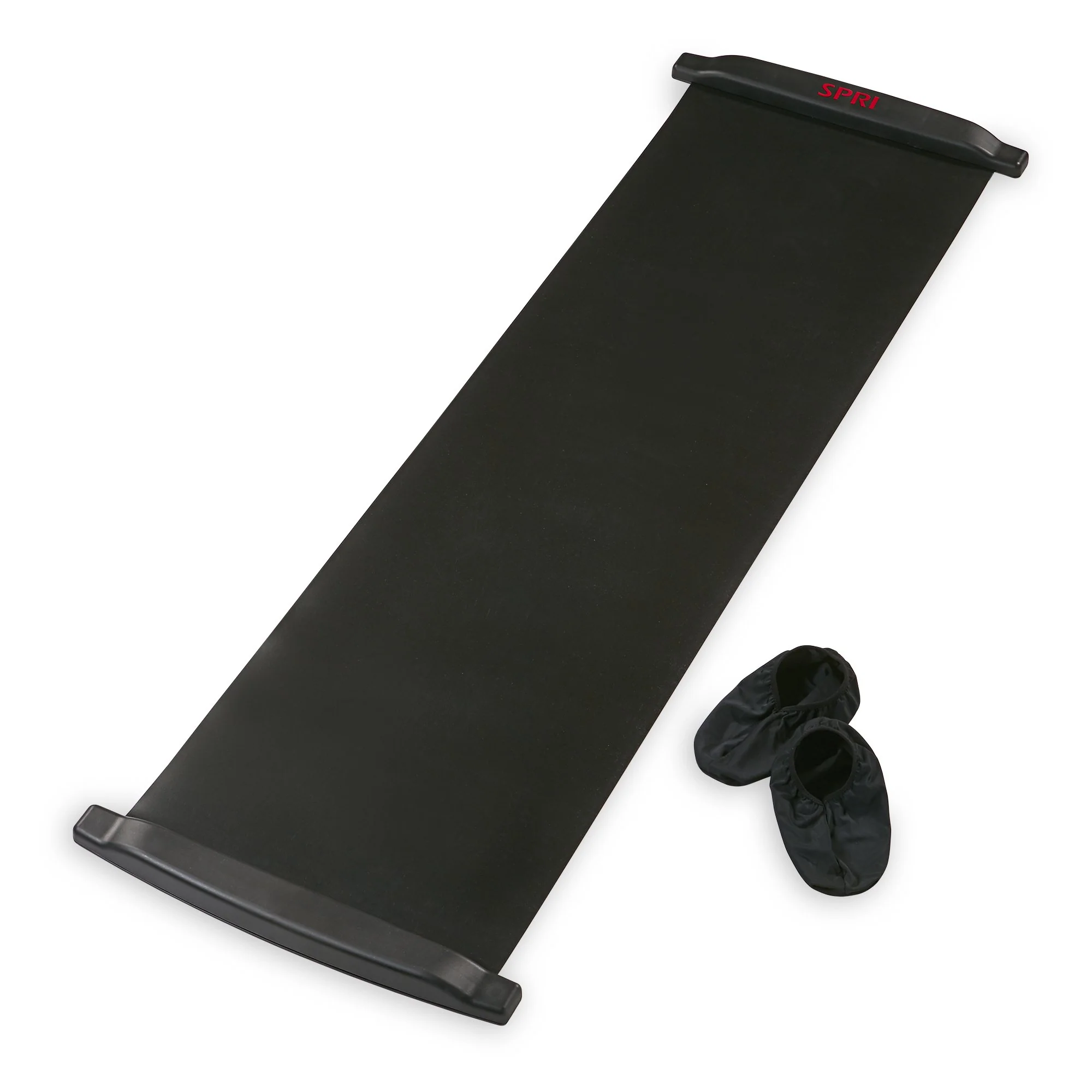Over the recent years, many have switched to working out at home. While there are a lot of options to train with different tools, one that is both versatile and fun is the slide boards. It is equally fit for athletes looking to enhance their performance or people who are looking to switch up their routines with a fun and effective workout. Slide board exercises offer a range of benefits for anyone. In this blog, we’ll explore the world of slide board workouts, including exercises, benefits, and tips.
What Is a Slide Board?
A slide board, also known as a lateral slide board or a lateral trainer, is a fitness tool designed to help improve lateral movements, balance, and overall body strength. It is a rectangular board with an average size of between 45 and 60 cm (18″ and 24″) in width. It consists of a smooth, slick surface, usually made of plastic or synthetic materials with high durability.
For the workout, specialized booties or footwear that allow for low-friction sliding are recommended. You can place the slide board on a flat surface, such as a hardwood floor or exercise mat, to perform various exercises.
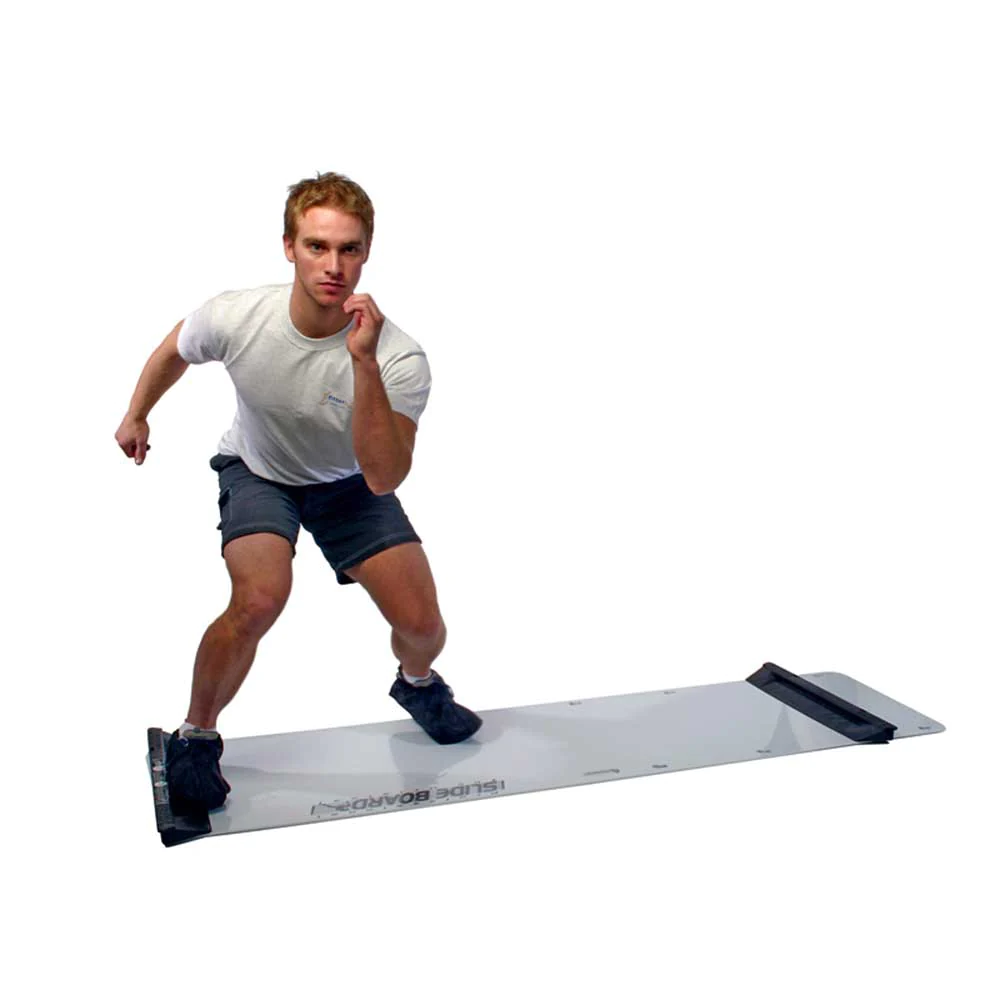
What Muscles Does a Slide Board Work?
A slide board is a versatile fitness tool that engages multiple muscle groups, providing a comprehensive workout. The primary muscles targeted during slide board exercises include:
- Quadriceps: The muscles on the front of your thighs are heavily engaged during various slide board movements, especially during exercises like lateral slides, reverse lunges, and mountain climbers.
- Hamstrings: The muscles on the back of your thighs are activated as you push off and slide your feet back in, such as during the reverse lunges and mountain climbers.
- Glutes: These muscles play a significant role in stabilizing your hips and thighs during lateral movements, making exercises like lateral slides and reverse lunges effective for targeting the glutes.
- Adductors and Abductors: The inner thigh muscles (adductors) and outer thigh muscles (abductors) are engaged during lateral slides and other side-to-side movements, contributing to improved hip stability and strength.
- Calves: The muscles in your calves are activated as you push off the sliding foot and extend your ankle during various exercises.
- Core Muscles: Your core muscles, including the rectus abdominis, obliques, and transverse abdominis, are engaged to stabilize your body during slide board exercises. This helps improve overall core strength and stability.
- Hip Flexors: These muscles, located at the front of your hips, are involved in movements that bring your legs forward, such as during mountain climbers.
- Shoulders and Triceps: Slide board exercises like plank slides require upper body strength, engaging muscles in the shoulders and triceps.
Stabilizing Muscles: Many slide board exercises require stability and balance, activating smaller stabilizing muscles throughout the body.
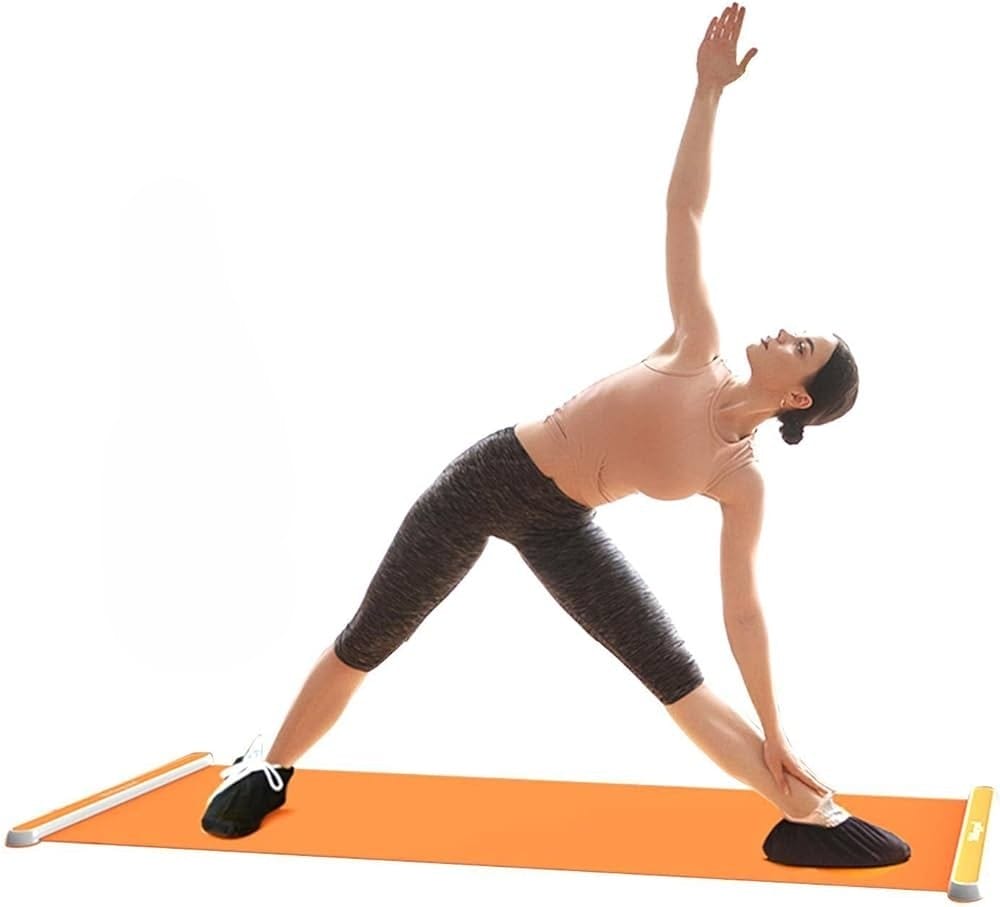
By incorporating various slide board exercises into your workout routine, you can effectively target and strengthen these muscle groups, promoting overall functional fitness and athleticism. It’s important to maintain proper form during slide board workouts to maximize the engagement of these muscles and reduce the risk of injury.
Benefits of Slide Board Workouts
Workouts on slide boards are very beneficial for hobby and professional atheletes. The side-to-side movements improve lateral movements, which are essential in sports like hockey, basketball, or figure skating. Practicing on a slide boardcan also result in a better overall stability and coordination. As mentioned above, a lot of different muscles are engaged, resulting in an effective full-body workout.
Another benefit is the cardiovascular fitness with low-impact movement which is easy on the joints. It is also a great tool to burn a signicant number of calories. Various slide board exercises work the core muscles, contributing to a stronger and more stable midsection.
Why a Slide Board is a Great Tool for Hockey Players and Figure Skaters
Advantages for Hockey Players:
For hockey players, incorporating slide board workouts into their training offers many advantages that directly translate to enhanced on-ice performance. Hockey is a sport that demands quick lateral movements, agility, and lower body strength. Slide board exercises, such as lateral slides closely mimic the dynamic motions involved in skating.
Furthermore, the emphasis on lateral stability during slide board exercises is particularly beneficial for hockey players who need to maintain balance and control while maneuvering on the ice. Developing these stabilizing muscles improves agility and reduces the risk of injury during intense game situations.
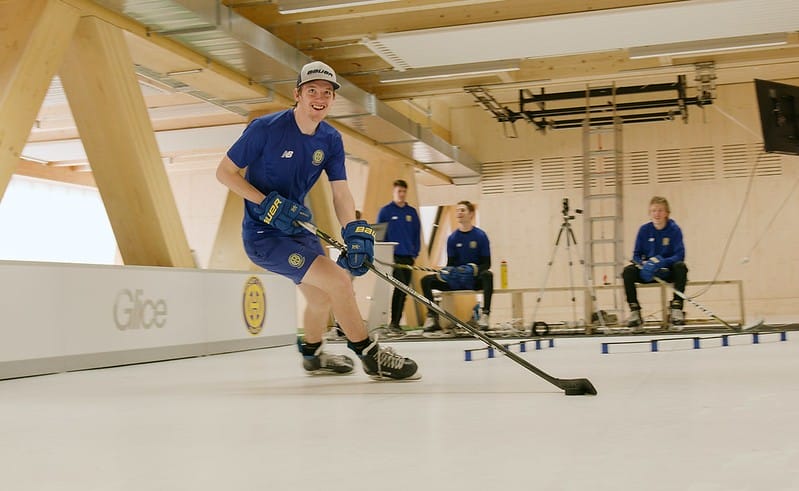
Advantages for Figure Skaters:
Figure skaters, known for their graceful yet powerful movements on the ice, find immense benefits in incorporating slide board workouts into their off-ice training. Figure skating demands a unique blend of strength, flexibility, and balance. Slide board exercises, focusing on lateral movements and core engagement, align perfectly with the requirements of figure skating routines.
The lateral slides on the board help figure skaters strengthen the muscles in their thighs and hips, which are crucial for executing jumps, spins, and intricate footwork. The emphasis on balance during these exercises also enhances the skater’s ability to maintain control and poise, essential elements in figure skating performances.
The low-impact nature of slide board exercises is particularly advantageous for figure skaters. It provides a challenging workout without putting excessive strain on the joints, which is crucial for preventing injuries that could hinder their on-ice performances.
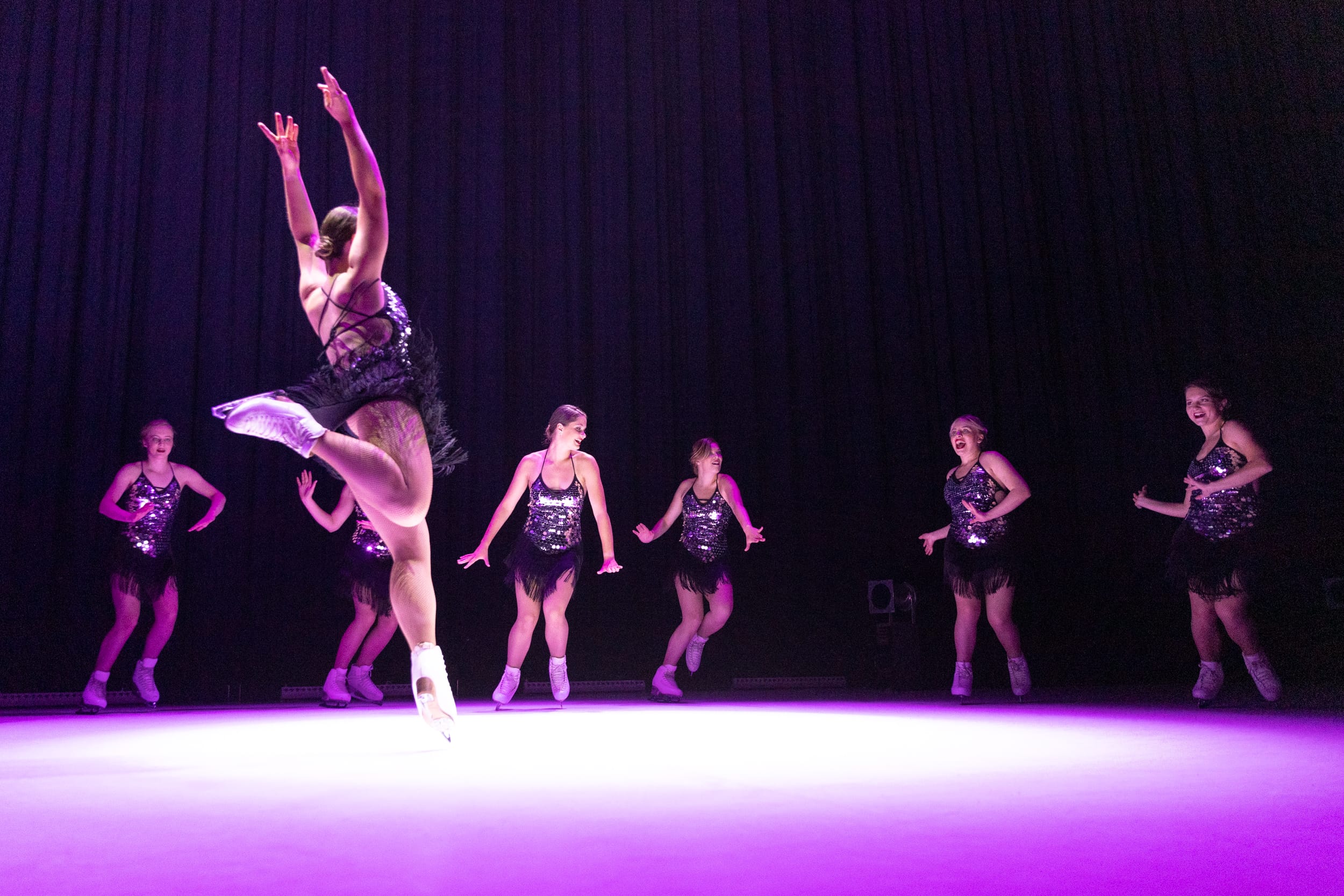
Tips for a Successful Slide Board Workout
- Proper Footwear: Wear the provided booties or use appropriate athletic shoes with a low-friction sole to ensure smooth sliding.
- Warm-Up: Perform a dynamic warm-up to prepare your body for the exercises and reduce the risk of injury.
- Start Slow: If you’re new to slide board workouts, start with basic exercises and gradually increase the intensity as you become more comfortable.
- Maintain Control: Focus on maintaining proper form and control throughout each exercise to maximize effectiveness and minimize the risk of injury.
- Hydrate and Cool Down: Stay hydrated during your workout and conclude with a cool-down to aid in recovery.
Popular Slide Boards Brands
SPRI Slide Board
This PVC – slide board has recently gained popularity and is an economical option, especially for beginners. You can purchase it on different platforms for around $40.
Lateral Edge Slide Board
The Lateral Edge Slide Board is especially designed for athletes and made from a solid sheet, making it more endurable. The purchase includes a 3-month membership to the workout program. Purchase it here.
ProGuard Slide Board
ProGuard is known for producing high-quality slide boards designed for various fitness levels. They often offer durable boards with adjustable features. Their slide board is available for around $70 in the US.
Factors Influencing Cost:
- Material and Build Quality: The type of material used in the slide board construction, and the overall build quality
- Size and Length: Longer boards may be more expensive due to the additional material used
- Additional Features: Some slide boards come with extra features such as adjustable inclines, resistance bands, or special coatings to enhance the sliding experience.
- Brand Reputation: Well-established and reputable brands may charge a premium for their products
- Portability and Storage: Slide boards that are designed to be portable or easily stored may be more expensive
Price Range:
The cost of slide boards can vary widely. Basic models may be available for around $50 to $100, while more advanced and feature-rich options could range from $100 to $300 or more. It’s advisable to check the latest prices and customer reviews for specific products, as they may have changed since my last update.
Exercises for Your Slide Board Workout
There exists a grand variety of exercises adapted to slide boards. As seen above, the tool can be your reliable partner for a whole-body workout. These are some of our favorites:
Lateral Slides
Start by standing on the slide board with one foot on each end. Bend your knees a little and slide one foot out to the side and bring it back in, then repeat on the other side. While you are moving across the board, swing your arms from one side to the other. This exercise targets the inner and outer thighs, hip muscles, and helps improve balance.
Mountain Climbers

One of our favorite core exercises: Go into a push-up position with hands and feet on the slide board (you can also place your hands on the floor; the feet play the important role here). Bring one knee towards your chest and back by sliding one foot forward along the board. Repeat by alternating both legs. This exercise is an excellent full-body workout that also engages your core.
You can upgrade this exercise by moving both legs towards your chest at the same time into a tuck position.
Reverse Lunges
Stand on the slide board with your feet hip-width apart. Slide one foot backward into a reverse lunge, then return to the starting position. This exercise works your glutes, hamstrings, and quadriceps.
Skater Squat Circles
Stand on the slide board and sink into a little squat, as if you were sitting down on a chair. Be careful to keep a straight back and not hunch over your back during this exercise. Keeping a tight core, slide one leg out to the side and draw a circle with your foot. Repeat with the other leg.
Side Lunges
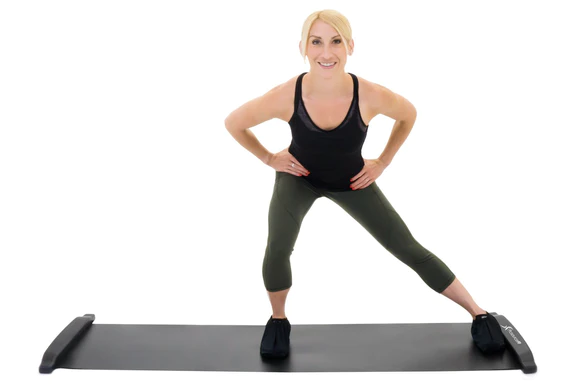
Stand on the slide board and squat down a little. Start by sliding one foot out to the side while bending your standing leg. Ensure not to move the foot out too far, to move it back towards your standing leg without risk of injury. Then repeat with the other leg and alternate.
Plank Jacks
Start in a plank position with your feet together and on the slide board, hands on the floor. Next, slide your feet away from each other, opening the legs. Then, pull your feet back together and repeat. Ensure to engage your core at all times. Apart from the upper body, his exercise really works your glutes and thighs.
Slide Board Burpee
To do the Slide Board Burpee, start standing tall with your feet close together. Then squat down and bend over to place your hands on the ground. With your hands on the ground, slide your feet back so that you are in a Plank position with your hands under your shoulders. Then, slide your feet back into your hands and stand back up, squeezing your glutes at the top.
Push Ups
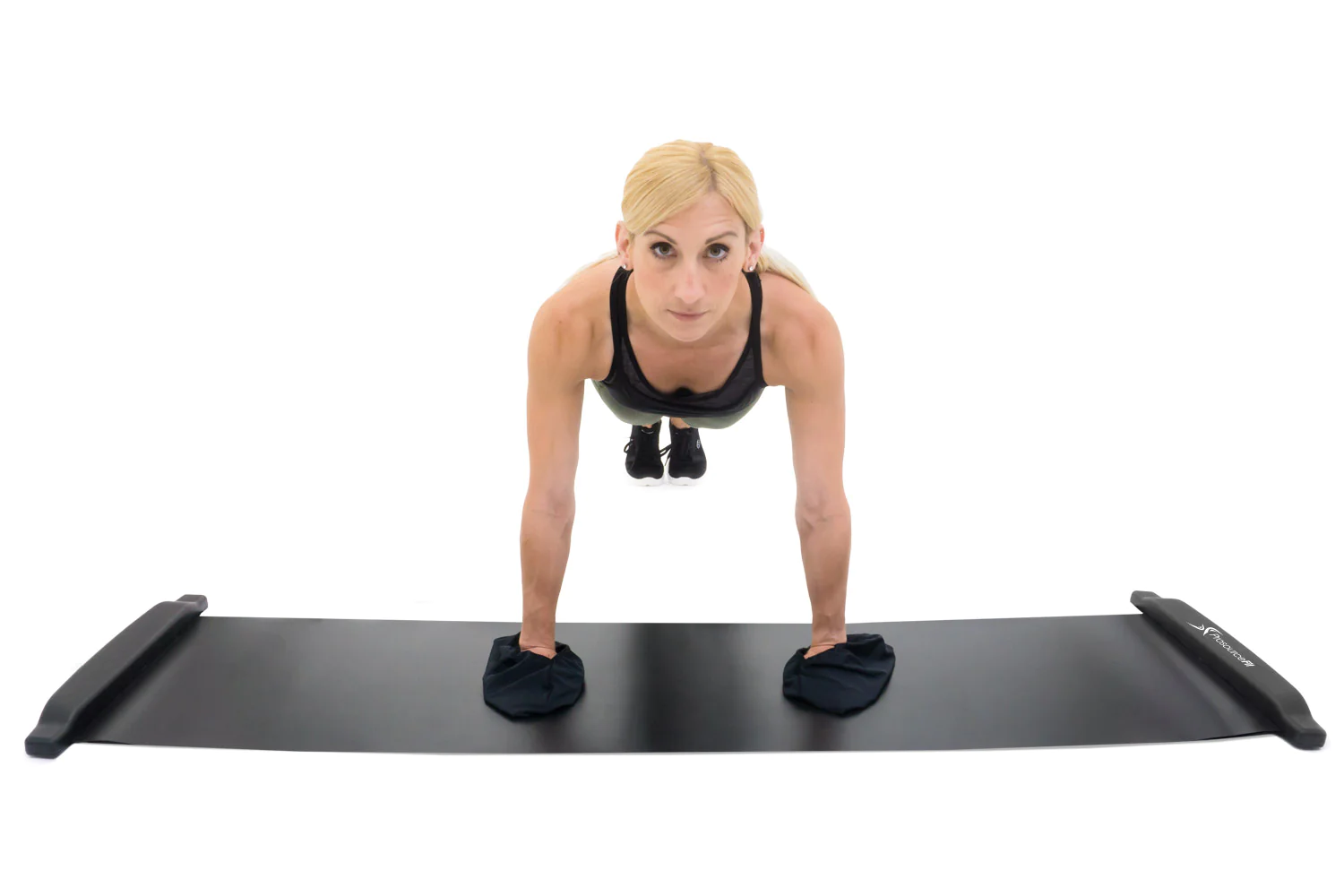
For this exercise, place the booties on your hands and go into a plank position with your hands on the slide board. Keep your hands under your shoulders and your body in a straight line. Keep your feet close to make this move even more challenging, or keep them broad for a more stable position.
Next, slide your hands outwards and simultaneously lower your chest to perform a push-up. Move your chest as close to the ground as possible while still being able to push back up. Then, while pressing yourself up again, pull your hands back in so they are under your shoulders again.
Posterior Plank to L-Sit
For this move, sit on the slide boards with your legs straight and your hands behind your butt. Then, with straight legs, move your hips into a bridge by sliding your feet out. Keep a tight core while you stay in this position for a few seconds. The slide back to the original position, but keeping your butt about an inch off the ground. Then, repeat several times, never letting your butt touch the ground.
Want More? Try Synthetic Ice!
The application of synthetic ice surfaces transcends the limitations of traditional slide boards, especially for athletes seeking a more comprehensive and sport-specific training experience. Synthetic ice offers a remarkably realistic simulation of on-ice conditions, making it an invaluable tool for hockey players and figure skaters.
Unlike slide boards, synthetic ice allows athletes to use their actual skates, replicating the exact muscle engagement and proprioception experienced on the ice. This authenticity translates into enhanced skill transfer, enabling athletes to fine-tune their skating techniques, practice intricate footwork, and execute sport-specific drills with unparalleled precision.
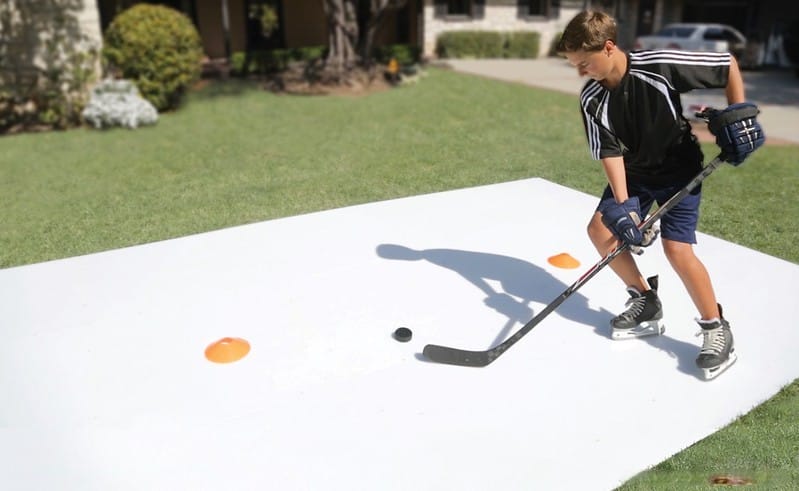
Moreover, the durability and versatility of synthetic ice make it a superior choice for athletes looking to integrate on-ice movements into their training regimen without being bound to the confines of a traditional rink. The ability to set up a synthetic ice surface virtually anywhere provides athletes with the flexibility to train at home or in a controlled environment, offering a level of convenience and accessibility that extends beyond the capabilities of a standard slide board.
In essence, synthetic ice emerges as a dynamic and advanced alternative, bridging the gap between off-ice training and on-ice proficiency for a more immersive and effective athletic development experience.
Conclusion
Slide board workouts offer a unique and effective way to improve lateral movement, balance, and body strength. Whether you’re an athlete or simply looking to diversify your home workout routine, slide boards can be a valuable addition. Consider synthetic ice, a durable, portable, and effective alternative for an enhanced home training experience. Contact one of our local representatives to learn more. Whichever workout you prefer, whether at home or in the gym, it is a good choice to be healthier, fitter, and prepared for whatever you set yourself to achieve.

